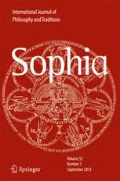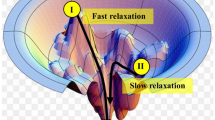Abstract
While Plantinga has famously argued that acceptance of neo-Darwinian theory commits one to the rejection of naturalism, Plantinga’s argument is vulnerable to an objection developed by Evan Fales. Not only does Fales’ objection undermine Plantinga’s original argument, it establishes a general challenge which any attempt to revitalize Plantinga’s argument must overcome. After briefly laying out the contours of this challenge, we attempt to meet it by arguing that because a purely naturalistic account of our etiology cannot explain the correlation between our preference for simplicity and simplicity’s ability to serve as a veridical method of theory selection, the scientific realist is committed to the rejection of naturalism.
Similar content being viewed by others
Notes
Many thanks to Evan Fales for helping us see this concern.
References
Aquinas, T. (1945). Basic writings of St. Thomas Aquinas, trans. A.C. Pegis. New York: Random House.
Baker, A. (2007). Occam’s razor in science: A case study from biogeography. Biology and Philosophy, 22(2), 193–215.
Barnes, J. (1994). Posterior analytics: Translated with a commentary (2nd ed.). Oxford: Clarendon Press.
Beilby, J. (1997). Is evolutionary naturalism self-defeating? International Journal for Philosophy of Religion, 42(2), 69–78.
Boudry, M., & Vlerick, M. (2014). Natural selection does care about truth. International Studies in the Philosophy of Science, 28(1), 65–77.
Boyd, R. N. (1983). On the current status of the issue of scientific realism. Erkenntnis, 19(1), 45–90.
Chakravartty, A. (2014). Scientific realism. The Stanford Encyclopedia of Philosophy (Summer 2017 Edition). E. N. Zalta (Ed.), URL = <https://plato.stanford.edu/archives/sum2017/entries/scientific-realism/>. Accessed 27 Nov 2018.
Churchland, P. (1985). The ontological status of observables: In Praise of the Superempirical Virtues. In P. M. Churchland & C. A. Hooker (Eds.), Images of Science: Essays on Realism and Empiricism, (with a reply from Bas C. van Fraassen). Chicago: University of Chicago Press.
Doppelt, G. (2014). Best theory scientific realism. European Journal for Philosophy of Science, 4(2), 271–291.
Enoch, D. (2010). The epistemological challenge to metanormative realism: How best to understand it, and how to cope with it. Philosophical Studies, 148(3), 413–438.
Epstein, R. (1984). The principle of parsimony and some applications in psychology. The Journal of Mind and Behavior, 5, 119–130.
Fairclough, S. H., & Houston, K. (2004). A metabolic measure of mental effort. Biological Psychology, 66(2), 177–190.
Fales, E. (1996). Plantinga’s case against naturalistic epistemology. Philosophy of Science, 63, 432–451.
Felsenstein, J. (1996). Inferring phylogenies from protein sequences by parsimony, distance, and likelihood methods. Methods in Enzymology, 266, 418–427.
Field, H. (1989). Realism, mathematics and modality. New York: Blackwell.
Fitelson, B., & Sober, E. (1998). Plantinga’s probability arguments against evolutionary naturalism. Pacific Philosophical Quarterly, 79(2), 115–129.
Horton, R. (1967). African traditional thought and Western science. Part I. From tradition to science. Africa: Journal of the International African Institute, 37(1), 50–71.
Jackson, A. (2013). Simplicity, in mathematics and in art. Notices of the AMS, 60(7), 922.
Jones, B. C., Little, A. C., Penton-Voak, I. S., Tiddeman, B. P., Burt, D. M., & Perrett, D. I. (2001). Facial symmetry and judgements of apparent health: Support for a “good genes” explanation of the attractiveness–symmetry relationship. Evolution and Human Behavior, 22(6), 417–429.
Kahane, G. (2011). Evolutionary debunking arguments. Noûs, 45(1), 103–125.
Kuhn, T. S. (2012). The structure of scientific revolutions. Chicago: University of Chicago press.
Law, S. (2011). Naturalism, evolution and true belief. Analysis, 72(1), 41–48.
Lipton, P. (2003). Inference to the best explanation. Abingdon: Routledge.
Machery, E. & Mallon, R. (2010). The evolution of morality. In J. M. Doris & F. Cushman (Ed.), The moral psychology handbook (pp. 4–46). New York: Oxford University Press.
Martens, R. (2009). Harmony and simplicity: Aesthetic virtues and the rise of testability. Studies in History and Philosophy of Science Part A, 40(3), 258–266.
Masuda, T., Gonzalez, R., Kwan, L., & Nisbett, R. E. (2008). Culture and aesthetic preference: Comparing the attention to context of East Asians and Americans. Personality and Social Psychology Bulletin, 34(9), 1260–1275.
McKenna, M. C., Gruetter, R., Sonnewald, U., Waagepetersen, H. S., & Schousboe, A. (2005). Energy metabolism of the brain. In G. Siegel, R. W. Albers, S. Brady, & D. Price (Eds.), Basic neurochemistry: molecular, cellular and medical aspects, 7th ed. (pp. 531–558). Cambridge: Elselvier Academic Press.
Nolan, D. (1997). Quantitative Parsimony. The British Journal for the Philosophy of Science, 48(3), 329–343.
Norton, J. D. (2000). Nature is the realisation of the simplest conceivable mathematical ideas’: Einstein and the canon of mathematical simplicity. Studies in History and Philosophy of Science Part B: Studies in History and Philosophy of Modern Physics, 31(2), 135–170.
Palter, R. (1970). An approach to the history of early astronomy. Studies in History and Philosophy of Science Part A, 1(2), 93–133.
Plantinga, A. (1993). Warrant and proper function. Oxford: Oxford University Press.
Plantinga, A. (2011). Where the conflict really lies: Science, religion, and naturalism. Oxford: Oxford University Press.
Riesch, H. (2010). Simple or simplistic? Scientists’ views on Occam’s razor. Theoria. Revista de Teoría, Historia y Fundamentos de la Ciencia, 25(1), 75–90.
Robbins, J. W. (1994). Is Naturalism Irrational? Faith and Philosophy 11(2), 255–259.
Rosfort, R. (2013). Folk physics. In Encyclopedia of sciences and religions (pp. 863–863). Dordrecht: Springer.
Rudner, R. (1961). An introduction to simplicity. Philosophy of Science, 28, 109–119.
Saatsi, J. T. (2007). Living in harmony: Nominalism and the explanationist argument for realism. International Studies in the Philosophy of Science, 21(1), 19–33.
Spade, P.V., Panaccio, C. (2016). William of Ockham. The Stanford Encyclopedia of Philosophy (Winter 2016 Edition), E. N. Zalta (Ed.), URL = <https://plato.stanford.edu/archives/win2016/entries/ockham/>. Accessed 27 Nov 2018.
Stanford, K. (2016). Underdetermination of scientific theory. The Stanford Encyclopedia of Philosophy (Winter 2017 Edition). E. N. Zalta (Ed.), forthcoming URL = <https://plato.stanford.edu/archives/win2017/entries/scientific-underdetermination/>. Accessed 27 Nov 2018.
Stephens, C. L. (2001). When is it selectively advantageous to have true beliefs? Sandwiching the better safe than sorry argument. Philosophical Studies, 105(2), 161–189.
Van Fraassen, B. C. (1980). The scientific image. Oxford: Oxford University Press.
Van Fraassen, B. C., Churchland, P. M., & Hooker, C. A. (1985). Images of science: Essays on realism and empiricism. Chicago: University of Chicago Press.
Wu, J. S. (1969). Chinese language and Chinese thought. Philosophy East and West, 19(4), 423–434.
Author information
Authors and Affiliations
Corresponding author
Additional information
Publisher’s Note
Springer Nature remains neutral with regard to jurisdictional claims in published maps and institutional affiliations.
Rights and permissions
About this article
Cite this article
Graber, A., Golemon, L. Plantinga Redux: Is the Scientific Realist Committed to the Rejection of Naturalism?. SOPHIA 59, 395–412 (2020). https://doi.org/10.1007/s11841-018-0695-0
Published:
Issue Date:
DOI: https://doi.org/10.1007/s11841-018-0695-0




